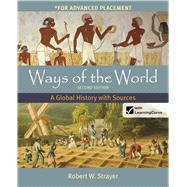A book that helps students see the big picture
Ways of the World has quickly become one of the most widely adopted new world history textbooks and offers a genuine alternative for your world history survey. Designed as a brief text, Ways of the World focuses on the big picture of significant historical trends, themes, and developments. Author Robert W. Strayer, a pioneer in the world history movement with years of classroom experience, provides a thoughtful and insightful synthesis. The brief narrative allows you to supplement with your own readings and course materials and provides an affordable option for your students. The second edition rolls out Bedford/St. Martin's new digital history tools, including LearningCurve, an adaptive quizzing engine that garners over a 90% student satisfaction rate, and LaunchPad, the all new interactive e-book and course space that puts high quality easy-to-use assessment at your fingertips. Easy to integrate into your campus LMS, and featuring video, additional primary sources, a wealth of adaptive and summative quizzing, and more, LaunchPad cements student understanding of the text while helping them make progress toward learning outcomes. It's the best content joined up with the best technology.









